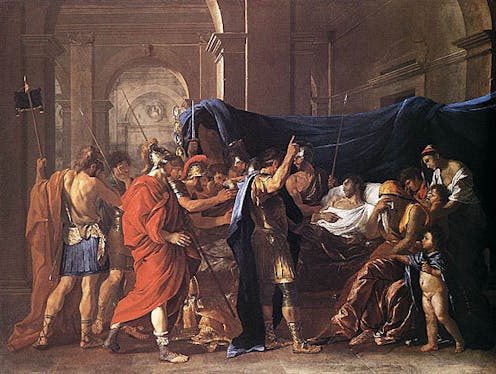 The death of popular prince Germanicus painted by Nicolas Poussin in 1627.Senex Magister/flickr
The death of popular prince Germanicus painted by Nicolas Poussin in 1627.Senex Magister/flickr Sometime in the 9th century AD, a monk in the Benedictine monastery of Fulda in modern Germany copied out an extensive Latin history into Carolingian minuscule, a script promoted by the emperor Charlemagne to aid in the reading and comprehension of great works of literature. It is to this monk that we owe the preservation of the first part of what is arguably the greatest history of imperial Rome, the Annals of P. Cornelius Tacitus.
The Annals tells the story of the Roman empire under the Julio-Claudian dynasty, which ruled Rome from 27 BC to AD 68. It begins with the death of the first emperor Augustus (27 BC-AD 14), and then covers in detail the reigns of his successors, Tiberius (AD 14-37), Caligula (AD 37-41), Claudius (AD 41-54), and Nero (AD 54-68).
The history was originally composed of 18 books, of which 1-6 are preserved in the manuscript from Fulda, and 11-16 in a second manuscript copied in Italy at the monastery of Monte Cassino in the 11th century.
Read more: Guide to the Classics: Suetonius's The Twelve Caesars explores vice and virtue in ancient Rome
The rest of the work, including the entire reign of Caligula, is entirely lost. What remains, however, is a powerful and at times darkly humorous examination of the workings of the Roman imperial monarchy.
Without anger and partiality
Tacitus was a Roman senator, who wrote the Annals in the early second century AD, during the reigns of Trajan (AD 98-117) and Hadrian (AD 117-138). He had previously written a series of minor works, including a biography of his father-in-law Agricola, and a major account of the Flavian dynasty (AD 69-96) called the Histories.
The Annals is a modern title, which only became established in the 16th century. The 9th century manuscript from Fulda instead began with Ab excessu divi Aug(usti), “From the death of the deified Augustus”. The choice of Annals as the conventional title reflects the fact that Tacitus’ history was structured on an annalistic basis, covering events year by year.
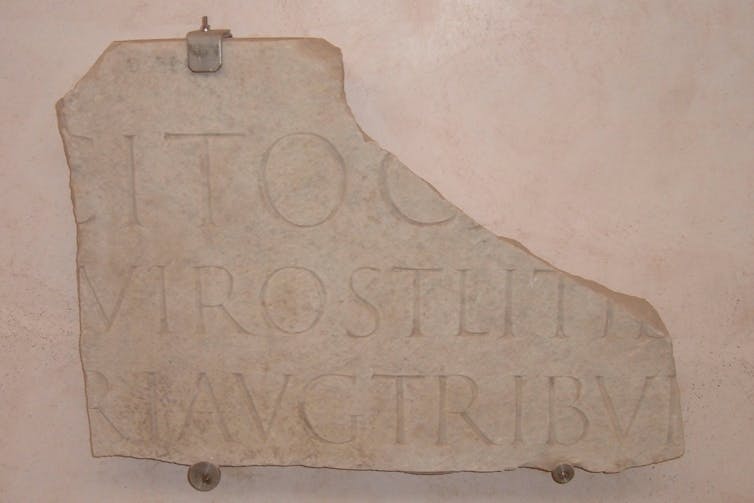 Fragment of the funerary inscription of P. Cornelius Tacitus, Museo Nazionale Romano, Rome.Kleuske/Wikimedia Commons, CC BY-SA
Fragment of the funerary inscription of P. Cornelius Tacitus, Museo Nazionale Romano, Rome.Kleuske/Wikimedia Commons, CC BY-SAThe most famous statement of Tacitus’ Annals is his proclamation that he would write sine ira et studio (“without anger and partiality”). Such pronouncements of impartiality were a formulaic part of ancient historiography. In this case, Tacitus’ claim is based on the fact that he did not live under the emperors he was writing about, and thus did not benefit from their patronage. The statement did not mean that he would refrain from advancing any strong opinions – far from it.
Liberty and slavery
The City of Rome from its inception was held by kings; freedom and the consulship were established by L. Brutus.
From this, the first line of the Annals, Tacitus lays his cards on the table with an account of Rome’s changing systems of government. Rome had been a monarchy before, in the age of the kings which lasted for nearly 250 years (753 BC-509 BC). In 509 BC, a senator called L. Brutus expelled the tyrannical last king, Tarquinius Superbus. This ushered in an era of libertas (“freedom”).
Tacitus describes how freedom was guaranteed by a new form of government, the res publica – the Republic – in which sovereign authority lay with the Roman people. In the first century BC, a series of civil wars waged by powerful men such as Julius Caesar, Mark Antony and Octavian effectively brought about the end of the Republican system of government.
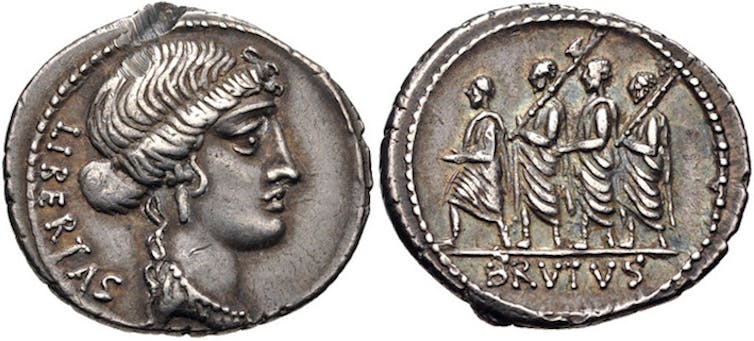 Roman coin of 54 B.C. celebrating Brutus’ expulsion of Tarquinius Superbus and the new era of freedom in 509 B.C.Wikimedia Commons
Roman coin of 54 B.C. celebrating Brutus’ expulsion of Tarquinius Superbus and the new era of freedom in 509 B.C.Wikimedia CommonsIn 27 BC, Octavian assumed the name of Augustus (“the revered one”) and became the first emperor. Monarchical rule had returned to Rome. Although the senate still existed, real power now lay with Augustus. Tacitus writes that the people and the senators, grateful for the end to civil wars, offered themselves up in servitium (“servitude”) to Rome’s new leader:
he (sc. Augustus) drew to himself the responsibilities of senate, magistrates, and laws - without a single adversary, since the most defiant had fallen in the battle line or by proscription and the rest of the nobles […] preferred the protection of the present to the perils of old.
The themes of liberty and slavery permeate the Annals. After the death of Augustus, Tacitus writes that senators turned to acknowledge his stepson Tiberius as emperor, a move which he characterises as “a rush into servitude”. This language was particularly resonant to a Roman audience, as Myles Lavan has shown. Servitude was the condition of slaves who answered to a dominus (“master”) – it was not the condition of free men, and especially not of Roman citizens.
Tacitus’ history alternates between civil affairs (concentrating on the emperor, the senate, and the court) and foreign affairs (campaigns and rebellions in the provinces). But each section of his narrative comments on and reflects the themes of the other.
A classic example comes in Book 14. Here Tacitus describes the revolt of Boudicca, queen of the British tribe of the Iceni, against the forces of the emperor Nero in Britain. Before joining battle with the Romans, Boudicca tells her followers that:
[…] she was not, as one sprung from great ancestors, avenging her kingdom and wealth, but as one of the people, her lost freedom, her body battered by beatings, and the abused chastity of her daughters.
To fight and die under the leadership of a woman would enable Britons to avoid slavery under Rome. Boudicca’s speech encourages Tacitus’ readers to reflect on the decadence and depravity of Nero, and the curtailment of freedom under his regime.
Read more: Mythbusting Ancient Rome – the emperor Nero
The monarchy exposed
The Annals is not an anti-monarchical work – when Tacitus was writing in the second century AD, there was no chance of the Roman Republic being restored. In his view, monarchical government should be conducted in an open and transparent manner, with the emperor and senate working together. But the reigns of the Julio-Claudians which he describes in the Annals did not live up to this ideal.
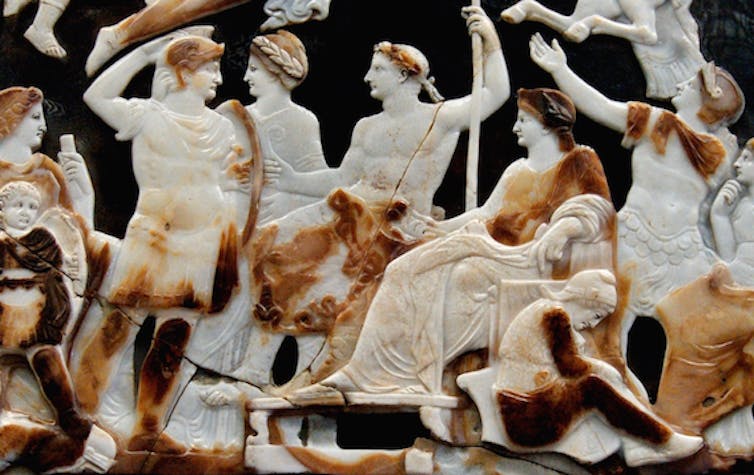 The emperor Tiberius shown on the Grand Camée de France, Bibliothèque Nationale, Paris.Carole Raddato/Wikimedia Commons, CC BY-SA
The emperor Tiberius shown on the Grand Camée de France, Bibliothèque Nationale, Paris.Carole Raddato/Wikimedia Commons, CC BY-SATacitus paints the members of the senate as sycophants, willingly surrendering their authority to their imperial masters. His account of the emperor Tiberius – portrayed as the master of dissimulation who says one thing but does another – features senators turning on one another to curry favour with the emperor, and with his notorious creature, the praetorian prefect Sejanus.
In Tacitus’ picture of the monarchy, the real power lies behind closed doors, where senators jockey for favour with men such as Sejanus, not to mention the emperor’s freedmen, slaves, and female relatives. In Book 11, which covers the reign of Claudius, we see a senator’s trial held in the imperial bedroom in the presence of the emperor and his wife Messalina – rather than in the senate itself.
Claudius’ second wife, his niece Agrippina, ushered in a new form of female tyranny. Tacitus memorably remarks:
[…] there was universal obedience to a female who did not, like Messalina, sport with Roman affairs through recklessness: it was a tightly controlled and (so to speak) manlike servitude.
In producing his account of political intrigues, Tacitus often conducted archival research. In Books two and three he describes the mysterious death of Tiberius’ adopted son Germanicus in Syria after he clashed with the governor of the province, Calpurnius Piso. Tacitus recounts the outpouring of grief for Germanicus in Rome, and the subsequent trial of Piso.
Bronze fragments of a senatorial decree recording the outcome of the trial were discovered in Spain in the 1980s. A comparison of the text of the inscription with the Annals shows that Tacitus used these senatorial records in writing about the death of Germanicus.
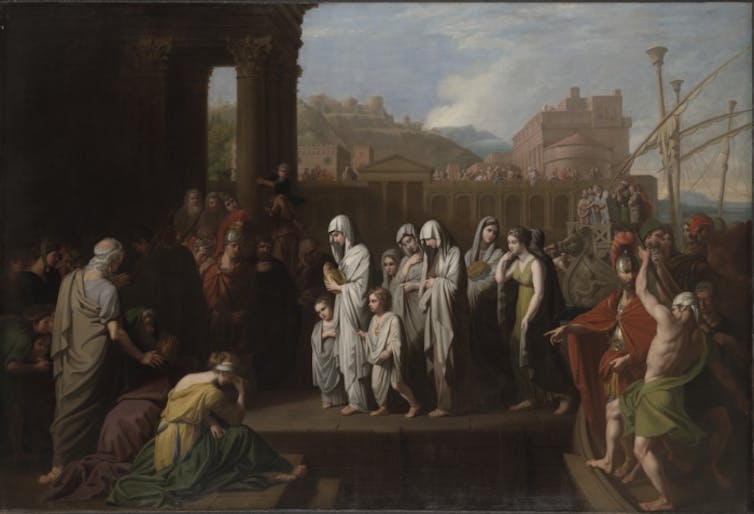 Agrippina Landing at Brundisium with the Ashes of Germanicus by Benjamin West.Wikimedia Commons
Agrippina Landing at Brundisium with the Ashes of Germanicus by Benjamin West.Wikimedia CommonsBut Tacitus does not accept the authorised version of events wholesale. He shapes his narrative of the incident to focus on the dissimulation of the emperor Tiberius and his mother Livia, whom he alleges were secretly happy at the death of the popular prince Germanicus:
Tiberius and Livia refrained from public appearance, deeming it would belittle their sovereignty to lament openly – or lest, with everyone’s eyes examining their demeanour, their falsity be understood.
We cannot know what Tiberius and Livia were really thinking, but Tacitus uses the power of rumour and suggestion to imagine the motives of the parties involved. The historian Werner Eck has drawn parallels between this incident and the aftermath of death of Princess Diana, when popular grief was famously greeted by a prolonged silence from the Queen.
A powerful legacy
Given Tacitus’ gift for laying bare the realities of power, it is somewhat surprising that he was never a popular author in the Roman world. Indeed, Tacitus was little read before the publication of the first editions of the Annals in the 16th century. His history struck a chord with Italian humanists, who found in the Annals a work which helped them to comprehend and critique the monarchical regimes of Europe.
Tacitus’ style influenced Francesco Guicciardini’s History of Italy, which recounted events in the peninsula between 1494-1534, and the relevance of the theme of liberty to contemporary monarchy was brought out in Virgilio Malvezzi’s Discourses on Tacitus (1635). The impact of the Annals was also felt in England, where Tacitus’ words encouraged statesmen to challenge the restrictions placed on them by the Stuart kings, lest they too fall under the thumb of a Tiberius or Nero.
The subsequent influence of Tacitus’ Annals on great thinkers such as Hobbes and Montesquieu has ensured that it has become a paradigmatic text for understanding one-man rule, both in ancient Rome and in the modern world. It encourages us to consider the dangers of accepting and acquiescing to an autocracy which has no checks and balances.
The translations used in this article come from A. J. Woodman, Tacitus: The Annals, Hackett Publishing Company (2004).
Caillan Davenport receives funding from the Australian Research Council.
Authors: Caillan Davenport, Senior Lecturer in Roman History, Macquarie University
| < Prev | Next > |
|---|







